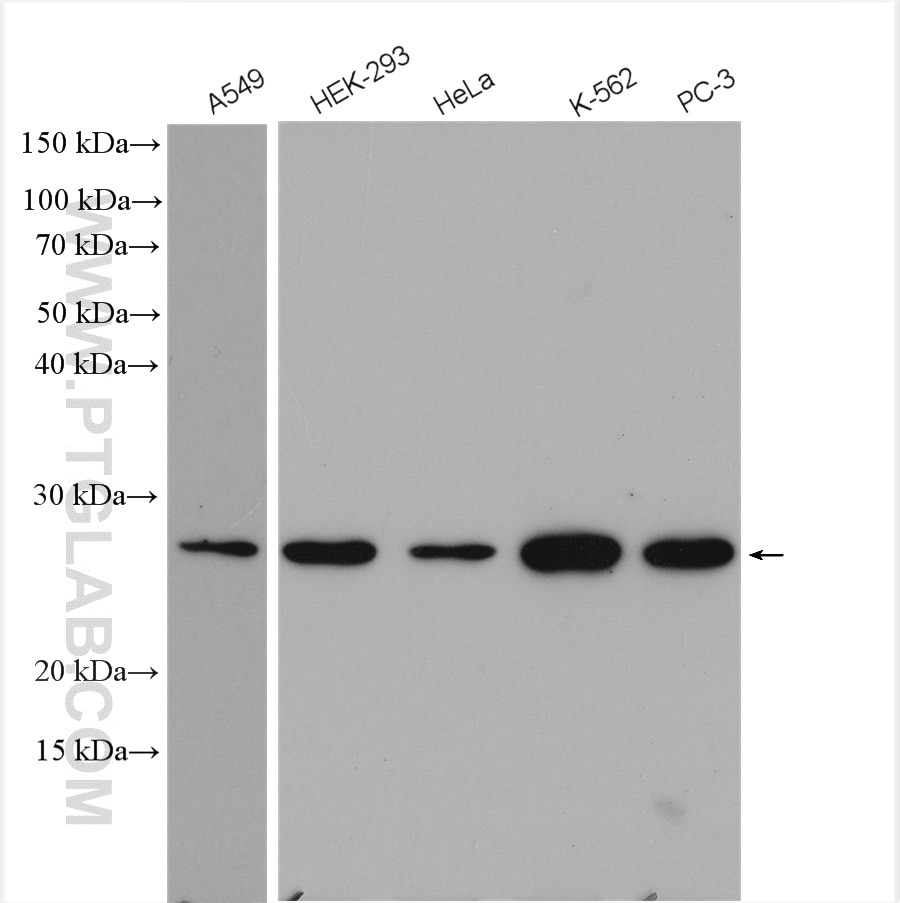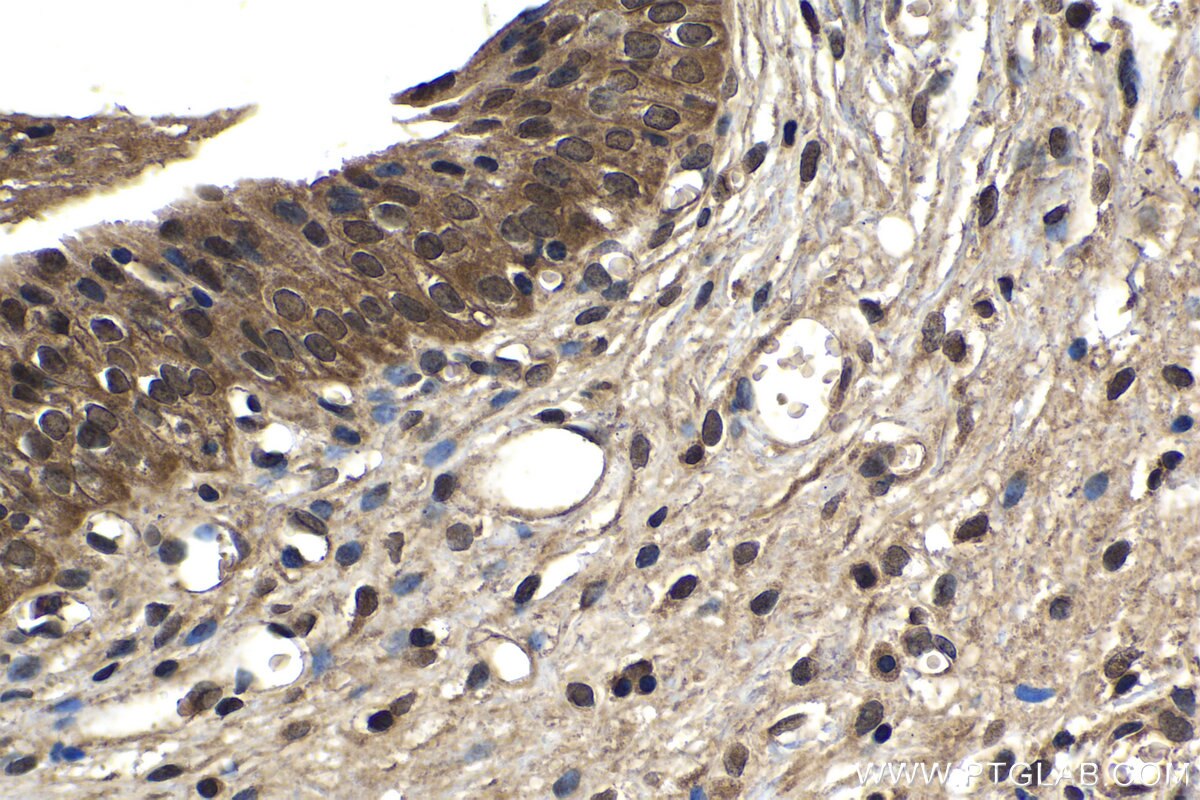Tested Applications
| Positive WB detected in | A549 cells, HEK-293 cells, HeLa cells, K-562 cells, PC-3 cells |
| Positive IHC detected in | human urothelial carcinoma tissue Note: suggested antigen retrieval with TE buffer pH 9.0; (*) Alternatively, antigen retrieval may be performed with citrate buffer pH 6.0 |
Recommended dilution
| Application | Dilution |
|---|---|
| Western Blot (WB) | WB : 1:500-1:2000 |
| Immunohistochemistry (IHC) | IHC : 1:250-1:1000 |
| It is recommended that this reagent should be titrated in each testing system to obtain optimal results. | |
| Sample-dependent, Check data in validation data gallery. | |
Published Applications
| KD/KO | See 1 publications below |
| WB | See 5 publications below |
Product Information
12342-2-AP targets PSMD10/Gankyrin in WB, IHC, ELISA applications and shows reactivity with human samples.
| Tested Reactivity | human |
| Cited Reactivity | human, mouse |
| Host / Isotype | Rabbit / IgG |
| Class | Polyclonal |
| Type | Antibody |
| Immunogen |
CatNo: Ag2994 Product name: Recombinant human PSMD10 protein Source: e coli.-derived, PGEX-4T Tag: GST Domain: 1-226 aa of BC011960 Sequence: MEGCVSNLMVCNLAYSGKLEELKESILADKSLATRTDQDSRTALHWACSAGHTEIVEFLLQLGVPVNDKDDAGWSPLHIAASAGRDEIVKALLGKGAQVNAVNQNGCTPLHYAASKNRHEIAVMLLEGGANPDAKDHYEATAMHRAAAKGNLKMIHILLYYKASTNIQDTEGNTPLHLACDEERVEEAKLLVSQGASIYIENKEEKTPLQVAKGGLGLILKRMVEG Predict reactive species |
| Full Name | proteasome (prosome, macropain) 26S subunit, non-ATPase, 10 |
| Calculated Molecular Weight | 226 aa, 24 kDa |
| Observed Molecular Weight | 24-28 kDa |
| GenBank Accession Number | BC011960 |
| Gene Symbol | PSMD10 |
| Gene ID (NCBI) | 5716 |
| RRID | AB_2172809 |
| Conjugate | Unconjugated |
| Form | Liquid |
| Purification Method | Antigen affinity purification |
| UNIPROT ID | O75832 |
| Storage Buffer | PBS with 0.02% sodium azide and 50% glycerol, pH 7.3. |
| Storage Conditions | Store at -20°C. Stable for one year after shipment. Aliquoting is unnecessary for -20oC storage. 20ul sizes contain 0.1% BSA. |
Background Information
PSMD10, also known as Gankyrin, is a subunit of the 19S regulatory particle of the proteasome and plays a crucial role in protein degradation. It is a small, 25 kDa cytoplasmic-nuclear shuttling protein, highly conserved throughout evolution (~40% identity to yeast Nas6p). PSMD10 is involved in the regulation of cell cycle progression and apoptosis by interacting with key proteins such as p53 and Rb. PSMD10 has been identified as an oncoprotein, promoting tumor cell proliferation and survival in various cancers (PMID: 16581249, PMID: 31576540).
Protocols
| Product Specific Protocols | |
|---|---|
| IHC protocol for PSMD10/Gankyrin antibody 12342-2-AP | Download protocol |
| WB protocol for PSMD10/Gankyrin antibody 12342-2-AP | Download protocol |
| Standard Protocols | |
|---|---|
| Click here to view our Standard Protocols |
Publications
| Species | Application | Title |
|---|---|---|
J Biomed Sci Znf179 E3 ligase-mediated TDP-43 polyubiquitination is involved in TDP-43- ubiquitinated inclusions (UBI) (+)-related neurodegenerative pathology. | ||
Appl Biochem Biotechnol miR-188-5p and Host MALAT1 Regulate RBE Cell Migration, Invasion, and Apoptosis via Up-regulating PSMD10 in Cholangiocarcinoma | ||
Research (Wash D C) SERBP1 Promotes Stress Granule Clearance by Regulating 26S Proteasome Activity and G3BP1 Ubiquitination and Protects Male Germ Cells from Thermostimuli Damage | ||
Elife A cleaved METTL3 potentiates the METTL3-WTAP interaction and breast cancer progression | ||
Nat Commun RNF167 mediates atypical ubiquitylation and degradation of RLRs via two distinct proteolytic pathways
|








